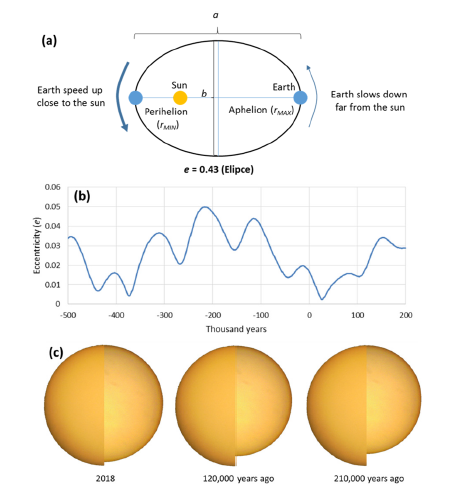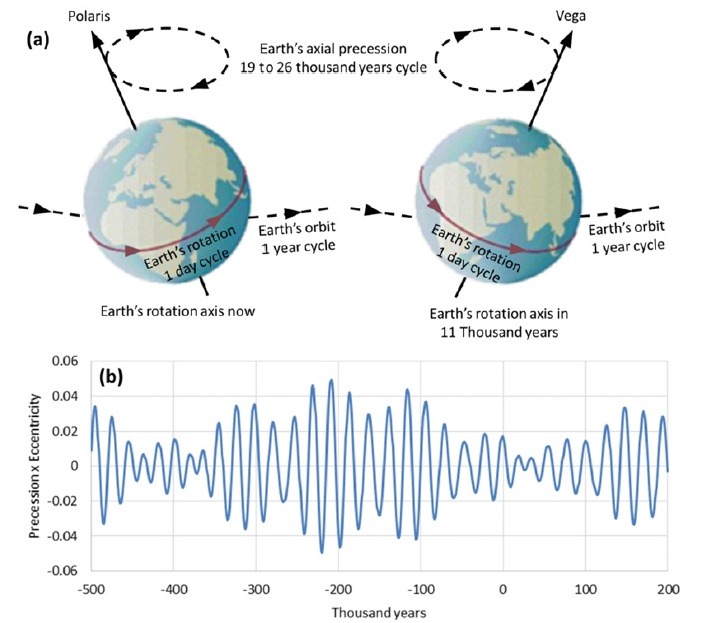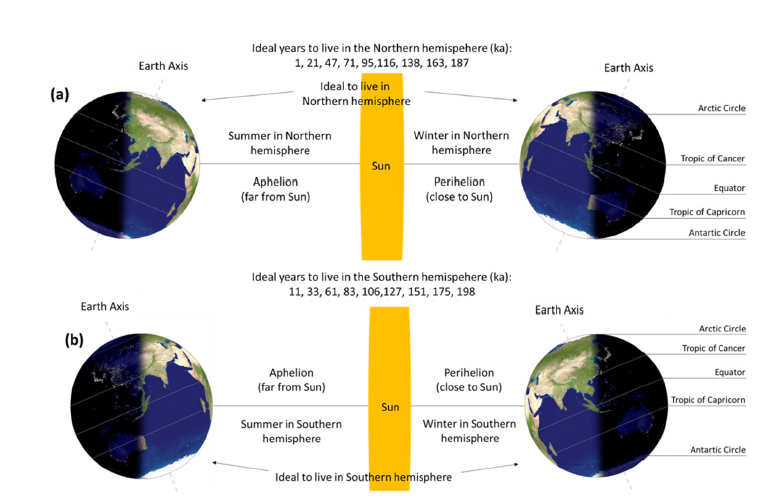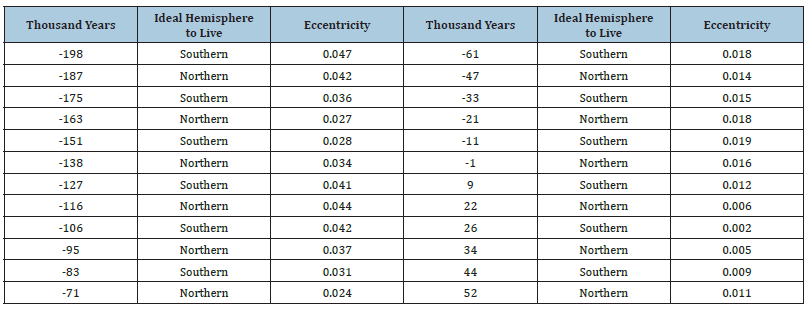- Submissions

Full Text
Archaeology & Anthropology:Open Access
The Ideal Climate Latitude: Orbit and Axial Precession Influence in Ancient Migration
Julian David Hunt1*, Kevin Lister2, Andreas Nascimento3 and Marcos Aurélio Vasconcelos de Freitas4
1International Institute for Applied Systems Analysis, Laxenburg, Austria
2Climate Restoration Foundation, Gloucester, United Kingdom
3Federal University of Itajubá, Itajubá, Brazil
4Federal University of Rio de Janeiro, Rio de Janeiro, Brazil
*Corresponding author: Julian David Hunt, International Institute for Applied Systems Analysis, Schlossplatz 1 - A-2361 Laxenburg, Austria
Submission: March 23, 2023Published: April 26, 2023

ISSN: 2577-1949 Volume4 Issue5
Abstract
It is widely understood that ice ages are periods when ancient humans constantly migrated mainly due to changes in climate. This article proposes that the combination of the precession of the Earth’s axis and the eccentricity of the Earth’s orbit around the world creates an ideal climate latitude, which has major impacts on migration patterns. During the ice ages the orbit of the Earth’s axis is considerably elliptic and the difference in distance from the Earth to the Sun during the perihelion and aphelion reached as much as 12%, which resulted in a difference of irradiation of 27%. The precession of the Earth’s axis changes the latitude where the Sun is perpendicular to the Sun during the aphelion and perihelion in a cycle of 19 to 26 thousand years. Ancient civilizations prevailed or purposely migrated to latitudes with the most favorable climate, where the aphelion happened during the summer and the perihelion happened during the winter. This article shows that major ancient migration patterns follow with some precision this ideal climate latitude.
Keywords:Ancient migrations; Earth’s axis precession; Ice ages; Climate change
Highlights
a. Review of the Earth’s axial precession and orbit variation in the past.
b. Influence of the Earth’s axial precession and orbit eccentricity in migration patterns.
c. Description of the variation of the ideal climate latitude with time.
d. Review of major migration patterns to verify the ideal climate proposal.
Introduction
During the last ice age (126-11 thousand years ago (ka)) ancient humans struggled with changes in climate and constantly migrated to cope with the harsh climate [1]. At that time, primitive man was a hunter/gatherer who lived in small nomad groups, which constantly migrated to locations with appropriate climate, water and food sources. Groups that migrated appropriately prevailed and the others went extinct. Several articles present a variety of different aspects which influenced ancient migration, for example freshwater availability [2-4], sea levels [5], glaciation [6], and orbital influences on climate change [1,7-9]. During the last ice age (126-11 thousand years ago (ka)) ancient humans struggled with changes in climate and constantly migrated to cope with the harsh climate [1]. At that time, primitive man was a hunter/gatherer who lived in small nomad groups, which constantly migrates to location with appropriate climate, water and food sources. Groups that migrated appropriately prevailed and the others were extinct. Several articles present a variety of different aspects which influenced ancient migration, for example freshwater availability [2-4], sea levels [5], glaciation [6], and orbital influences on climate change [1,7,8,9]. This paper argues that ancient migrations have been considerably influenced by two important astronomical variables: the eccentricity1 of the Earth’s orbit, which varies the distance between the Earth and the Sun during the perihelion2 and the aphelion3, and the precession of the Earth’s axis, which varies the date of the year when the perihelion and aphelion happen. It also argues that ancient humans migrated to or prevailed in latitudes where the perihelion happens during the winter, to keep warm, and the aphelion happens during the summer, to avoid excessive temperature rises. As the ideal climate location changed with the precession of the Earth’s axis then ancient human migrations went from the Northern hemisphere to the Southern hemisphere and back to the Northern hemisphere in a cycle of 19 to 26 thousand years to live in the optimum climate. This article is divided into five sections. Section 2 explains the most accepted causes of ice ages, the impact of eccentricity on the Earth’s orbit and the Earth’s axial precession in the solar irradiation on the Earth. Section 3 compares studies of ancient migrations with the proposed influence of the Earth’s axial precession on ancient migrations. Section 4 discusses how the Earth’s axial precession affected ancient migrations and how it will affect the Earth’s climate in the next thousand years. Section 5 concludes this paper.
Methodology
Figure 1: (a) Influence of the Earth’s orbit eccentricity in ice ages (a high eccentric orbit of 0.43 was used for illustrative reasons) (b) Earth’s orbit eccentricity change with time [12] (c) relative changes in the size of the Sun from an observer on Earth [13].

Even though the causes of ice ages are still a highly debated topic [10], it is generally accepted that the astronomical movement of the Earth that mostly influences ice ages is the change in the eccentricity of the Earth’s orbit around the Sun, which completes a cycle every 100 ka [11]. As presented in Figure 1a, when the Earth’s orbit is elliptic, the Earth accelerated when it is close to the Sun and decelerates when it is far from the Sun, due the variation in gravitational attraction of the Sun to the Earth. This results in the Earth being farther from the Sun for a longer period than it is closer to the Sun, which cools down the Earth and contributes to ice ages. Apart from changes in the Earth orbit’s eccentricity, other aspects also contribute to ice ages, such as the precession and obliquity of the Earth’s axis, and positive and negative feedbacks (albedo effect, changes in oceanic currents etc.) [11]. Figure 1b shows how the Earth’s orbital eccentricity varies from 500 thousand years in the past to 200 thousand years in the future, according to recent estimates [12] based on the Milankovitch cycles. These changes in eccentricity can be used to estimate the changes in distance from the perihelion and aphelion by applying Eq. 1 and Eq. 2.

Where e is the Earth’s orbit eccentricity, a is the major axis of the orbit (the horizontal axis in Figure 1a) and b is the minor axis (the vertical axis in Figure 1a)..

Where rMAX is the Difference in Distance Between the Earth and the Sun (DDBES) during the aphelion and rMIN is the DDBES during the perihelion. Assuming an eccentricity of 0.043, which happened around 120,ss000 years ago, the DDBES during the perihelion and aphelion is approximately 9.0%, assuming the same orbit major axis of the orbit of today (299,200,000km). Currently, the DDBES during the perihelion and aphelion is 3.396, where the Distance Between the Earth and the Sun (DBES) during the perihelion is equal to 147.095.271km on the 4th of January and the DBES during the aphelion is equal to 152.091.174km on the 4th of July [13]. 120,000 years ago, the orbit of the Earth around the Sun was considerably more elliptic, the DBES during the perihelion was 143.180.000km, and during the aphelion was 156.032.800km. 210,000 years ago, the orbit of the Earth around the Sun was considerably more elliptic, the DDBES during the perihelion was 142.120.000km, and during the aphelion was 157.080.000km. Figure 1c presents the relative changes in the size of the Sun of current and ancient observers from the Earth. A rough estimate of the changes in solar radiation on the Earth (before passing through the atmosphere) with the distance between the Earth and the Sun can be done with Eq 3. In other words, the solar irradiation in Earth is inversely proportional to the square of the distance between the two bodies. This equation assumes that the Sun is a point. The inclusion of the Sun’s dimensions would further contribute to the increase in irradiation with the reduction in distance.

Where Q is the solar irradiation outside the Earth’s atmosphere, σ is the Stefan-Boltzman constant, T is the temperature of the Sun surface in Kelvin and d is the distance between the Earth and the Sun. Table 1 presents the difference in irradiation from the Sun to the Earth during the perihelion and aphelion and the yearly variation in irradiation in the ideal and non-ideal hemispheres to live. This assumes that the seasonal solar irradiation variations in a given latitude is 50% from winter to summer. It also shows that, if the person is in the ideal hemisphere to live, the higher the eccentricity, the smaller is the seasonal variation of solar irradiation. On the other hand, if the person is living in the nonideal hemisphere, the higher the eccentricity, the higher is the seasonal variation on solar irradiation. The DDBES during the perihelion and the aphelion today is 3.4%, which results in a difference in solar irradiation of outside the Earth’s atmosphere of 6.9%. 100,000 years ago, the difference in distance was 8.3%, which resulted in a difference in solar irradiation of 17.3%. 230,000 years ago, the difference in distance was 10.5%, which resulted in a difference in solar irradiation of 22.1%. As mentioned previously, an elliptical orbit affects the Earth’s latitude that receives more solar irradiation through the Earth’s orbit around the Sun. This change in solar irradiation in different latitudes varies with another astronomical movement called the precession of the Earth’s axis, as shown in Figure 2a. The precession of the Earth’s axis is the wobble of the Earth’s axis. This rotation can be seen from the Earth as every 50 to 70 years the stars and constellations at a given time in the year, for example the equinox, shifts 1 degree to the right. This cycle takes around 19 to 26 thousand years to complete [11] and its main impact on the Earth’s climate is the changes of latitudes and hemispheres when the Sun is perpendicular to the Earth during the perihelion and aphelion. The precession would not have any influence on the world’s climate if the Earth’s orbit were circular. Figure 2b presents the eccentricity of the Earth’s orbit multiplied by precession, which varies from 1, when the aphelion happens when the Sun is perpendicular to the Tropic of Cancer in the Northern hemisphere, and -1 when the aphelion happens when the Sun is perpendicular to the Tropic of Capricorn in the Southern hemisphere. Table 2 clarifies the years when people should be living in the Northern hemisphere (precession equals +1) or in the Southern hemisphere (precession equals -1). Nowadays, the perihelion happens around the 4th of January, where the Sun is perpendicular to the Earth close to Rio de Janeiro, Brazil and Gladstone, Queensland, Australia, which coincides with the summer in the Southern Hemisphere. The aphelion happens around the 4th of July, where the Sun is perpendicular to the Earth close to Cancun in Mexico and Hawaii in the US, which coincides with the summer in the Northern Hemisphere. Ancient humans would struggle to live in the perihelion during the summer as they would burn given that they do not have the appropriate technology to protect against the strong solar irradiation, which was unbearable for humans, especially with white skin. The problem, however, was not only to be in the perihelion in summer. If you are in the perihelion during the summer, after six months you would be in the aphelion during the winter, which resulted in colder winters. The ideal was to live in the perihelion during the winter and aphelion during the summer, which would result in relatively cold summers and warm winters. This concept is represented in Figure 3.
Table 1: Impact of orbit eccentricity in the solar irradiation difference in ideal and non-ideal hemisphere to live.

Figure 2:(a) Diagram representing the precession of the Earth’s axis (b) Earth’s axial precession multiplied by its orbit eccentricity around the Sun [12].

Figure 3:Ideal millennia to live in the (a) Northern hemisphere and in the (b) Southern hemisphere.

Table 2: Past and future dates where human should be living in the ideal climate

Results
This section intends to compare the changes in ideal climate hemisphere thesis as explained in the previous section and the patterns observed in ancient human migrations. Figure 4a presents the proposed ancient migrations based on the Earth’s axis and adjusted with the proposed ancient migrations in the literature [14,3]. The numbers in (Figure 4a) present the years when the ideal happened in the given hemispheres. It also corresponds to the end of a migration cycle, when the people would change the direction of the migration from North to South or vice-versa. It should be noted that these proposed dates only take into account the precession of the Earth’s axis, which were taken from [12]. An error in the estimation of the precession of the Earth’s axis would directly affect the proposed dates in this article. Assuming a 6-thousand-year error, this proposal matches with similar migration patterns in the literature. For example, humans left Africa around 116ka [3,14- 16], 95ka [3,14,16] and 71ka [1,14,15] ancient people migrated to Australia around 61ka [14,15,17,18] migration to Europe around 47ka [14,15-17,19,20] people lived in North America 21ka [15,16,21] people lived in the South America 11ka [15,22,23] and a thousand years ago most of the world population was located in the Northern hemisphere. Figure 4b presents the proposed migration patterns together with the variation in the Earth’s axial precession. The results presented in Figures 4a & 4b also assume that people have lived between the Cancer and Capricorn Tropics regardless of the precession of the Earth’s axis. This is because the seasonal variation between the tropics is not extreme, the atmosphere is thicker, which absorbs more solar radiation, and the climate is warmer and usually more humid.
Figure 4:Proposed ancient migrations (a) map and (b) graph, assuming the precession of the Earth’s axis and the hemisphere with the ideal climate. The numbers are represented in thousand years in the past (ka).

Discussion
Nowadays, most people are not aware of the Earth’s precession and that the perihelion happens around the 4th of January, when the Sun is perpendicular to the Earth close to Rio de Janeiro, Brazil and Gladstone, Queensland, Australia. The main reason is because the Earth’s orbit eccentricity is relatively small (0.0167), which results in a 3.4% difference in distance between the Sun and the Earth during the perihelion and aphelion [11]. Another reason is because the perihelion is happening in the Southern Hemisphere, which is mostly water and, thus, temperature variations in the Southern hemisphere are smaller than in the Northern hemisphere. Additionally, there is only a limited amount of land in the Southern hemisphere, which restricts the amount of people that could live in the Southern hemisphere. In 10,000 years in the future, the perihelion will happen during the summer in the Northern hemisphere, the temperatures will be considerably higher in the summer and lower in the winter as the aphelion would happen in the winter. This result is severe changes in the Northern Hemisphere climate.
100,000 years ago, the difference in size of the Sun seen from the Earth during the perihelion and aphelion was 8.3% and could be noticed by the naked eye during sunset. From 50,000 years ago until today, the earth’s eccentricity reduced together with the impact of the Earth’s axial precession on migration patterns. Until the next 100,000 years the eccentricity of the Earth’s axis will be even smaller than today’s (0.016). This means that the next ice age will be mild and that the impact of the Earth axial precession on the climate, migration patterns and on sea level will be smaller. Thus, the most important issue that will influence the world’s climate of the next 100,000 years is man-made climate change. Another impact from the precession of the Earth’s axis is the impact on sea levels [1,24]. As the Southern hemisphere is mostly water and most of the world’s land cover is in the Northern hemisphere. When the perihelion happens during the summer in the Southern hemisphere, as is the case of today. There is relatively more radiation hitting the oceans and thus sea levels rise. A major issue with the Ideal Climate Latitude theory is that it suggests that humans should be living in the Southern Hemisphere 11 ka. However, this period coincides with the Holocene, which is marked by human settlement expansion in the Northern Hemisphere. Possible factors that might have influenced this abnormal behavior could be that the deglaciation provided freshwater supply during the dry and hot summers, because the cold winters in the Northern Hemisphere became milder because of the end of the Younger Dryas period as shown in [25] and because the eccentricity of the Earth’s orbit was small (0.019), which reduced the influence of the precession of the Earth’s axis in the world’s climate.
Conclusion
This paper concludes that the precession of the Earth’s axis and the eccentricity of the Earth’s orbit have influenced ancient migrations. It also argues that the ideal climate to live on Earth is in the summer during the aphelion and in the winter during the perihelion and that this location changes with the precession of the Earth’s axis from the Northern to the Southern hemisphere and back to the Northern hemisphere in a cycle of 19 to 26 thousand years. The ideal climate concept proposed in this paper has been compared and validated by a series of ancient migration patterns proposed in the literature. The influence of the precession of the Earth’s axis on the Earth’s climate has considerably reduced due to the current low eccentricity of the Earth’s orbit. The low influence precession of the Earth’s axis will continue for the next 100,000 years. Thus, we should focus our efforts on reducing man-made climate change, as it will have a much higher contribution to climate change than the precession of the Earth’s axis. Future work will study how ancient civilizations might have used astronomy to guide them to the ideal climate latitude, considering that ancient calendars were based on the Earth’s axial precession, and the possible correlation of the perihelion and aphelion in ancient depictions of the Sun.
Declaration
This is a research paper that adheres to the International Journal of Anthropology and Ethnology Journal publishing policy, including ethics approval, consent to participate, consent for publication, availability of data and material, competing interests, funding and authors’ contributions.
References
- Timmermann A, Friedrich T (2016) Late Pleistocene climate drivers of early human migration. Nature 538: 92-95.
- Scholz CA, Johnson TC, Cohen AS, King JW, Peck JA, et al. (2007) East African megadroughts between 135 and 75 thousand years ago and bearing on early modern human origins. Proceedings of the National Academy of Sciences 104(42): 16416-16421.
- Tierney JE, DeMenocal PB, Zander PD (2017) A climatic context for the out-of-Africa migration. Geology 45(11): 1023-1026.
- Lamb HF, Bates CR, Bryant CL, Davies SJ, Huws DG, et al. (2018) 150,000-year palaeoclimate record from northern Ethiopia supports early, multiple dispersals of modern humans from Africa. Sci Rep 8(1): 1077.
- Lambeck K, Purcell A, Flemming NC, Finzi CV, Alsharekh AM, et al. (2011) Sea level and shoreline reconstructions for the Red Sea: Isostatic and tectonic considerations and implications for hominin migration out of Africa. Quaternary Science Reviews 30(25-26): 3542-3574.
- Misarti N, Finney BP, Jordan JW, Maschner HDG, Addison JA, et al. (2012) Early retreat of the Alaska Peninsula glacier complex and the implications for coastal migrations of first Americans. Quaternary Science Reviews 48: 1-6.
- Carto SL, Weaver AJ, Hetherington R, Lam Y, Wiebe EC (2009) Out of Africa and into an ice age: on the role of global climate change in the late Pleistocene migration of early modern humans out of Africa. Journal of Human Evolution 56(2): 139-151.
- Castañeda IS, Mulitza S, Schefuss E, Santos RAPD, Damsté JSS, et al. (2009) Wet phases in the Sahara/Sahel region and human migration patterns in North Africa. Proc Natl Acad Sci U S A 106(48): 20159-20163.
- Maslin M, Brierley CM, Milner AM, Shultz S, Trauth AMH. et al. (2014) East African climate pulses and early human evolution. Quaternary Science Reviews 101: 1-17.
- Maslin M (2016) Forty years of linking orbits to ice ages. Nature 540: 208-209.
- Muller R, MacDonald G (2000) Ice ages and atronomical causes. Praxis Publishing, Singapore.
- Laskar J, Robutel P, Joutel F, Gastineau M, Correia ACM, et al. (2004) A long term numerical solution for the insolation quantities of the earth. Astronomy and Astrophysics 428(1): 261-285.
- Nemiroff R, Bonnell J (2018) Astronomy Picture of the Day, NASA.
- Bae CJ, Douka K, Petraglia MD (2017) On the origin of modern humans: Asian perspectives. Science 358(6368): eaai9067.
- Oppenheimer S (2012) Out-of-Africa, the peopling of continents and islands: Tracing uniparental gene trees across the map. Philos Trans R Soc Lond B Biol Sci 367(1590): 770-784.
- DeMenocal PB, Stringer C (2016) Climate and the Peopling of the world. Nature 538: 49-50.
- Clarkson C, Smith M, Marwick B, Fullagar R, Wallis LA, et al. (2015) The archaeology, chronology and stratigraphy of Madjedbebe (Malakunanja II): A site in northern Australia with early occupation. Journal of Human Evolution 83: 46-64.
- Norman K, Inglis J, Clarkson C, Faith JT, Shulmeister J, et al. (2018) An early colonisation pathway into northwest Australia 70-60,000 years ago. Quaternary Science Reviews 180: 229-239.
- Fu Q, Posth C, Hajdinjak M, Petr M, Mallick S, et al. (2016) The genetic history of ice age Europe. Nature 534(7606): 200-205.
- Maixner F, Kyora BK, Turaev D, Herbig A, Hoopmann MR, et al. (2016) The 5300-year-old helicobacter pylori genome of the iceman. Science 351(6269): 162-165.
- Raghavan M, Steinrücken M, Harris K, Schiffels S, Rasmussen S, et al. (2015) Genomic evidence for the Pleistocene and recent population history of native Americans. Science 349(6250).
- Dillehay, TD, Ramírez C, Pino M, Collins MB, Rossen J, et al. (2008) Monte Verde: Seaweed, food, medicine, and the peopling of South America. Science 320(5877): 784-786.
- Fraser B (2014) The first south Americans: Extreme living. Nature 514(7520): 24-26.
- Timmermann A, Friedrich T, Timm OE, Chikamoto MO, Ouchi AA, et al. (2014) Modeling obliquity and CO2 effects on southern hemisphere climate during the past 408ka. Journal of Climate 27(5): 1863-1875.
- Buizert C, Keisling BA, Box JE, He F, Carlson AE, et al. (2018) Greenland-wide seasonal temperatures during the last deglaciation. Geophysical Research Letters 45(4): 1905-1914.
© 2023 Julian David Hunt. This is an open access article distributed under the terms of the Creative Commons Attribution License , which permits unrestricted use, distribution, and build upon your work non-commercially.
 a Creative Commons Attribution 4.0 International License. Based on a work at www.crimsonpublishers.com.
Best viewed in
a Creative Commons Attribution 4.0 International License. Based on a work at www.crimsonpublishers.com.
Best viewed in 







.jpg)






























 Editorial Board Registrations
Editorial Board Registrations Submit your Article
Submit your Article Refer a Friend
Refer a Friend Advertise With Us
Advertise With Us
.jpg)






.jpg)














.bmp)
.jpg)
.png)
.jpg)










.jpg)






.png)

.png)



.png)






